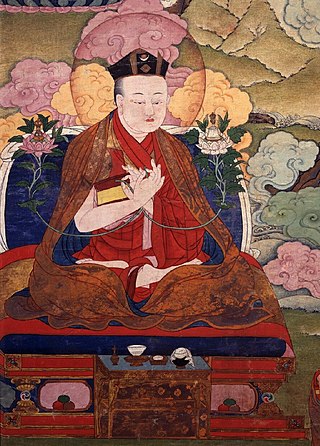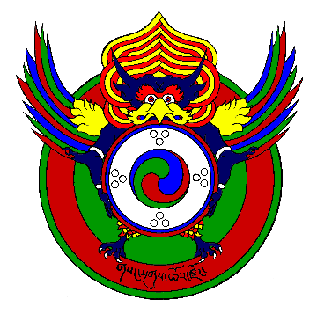
Tibetan Buddhism is a form of Buddhism practiced in Tibet, Bhutan and Mongolia. It also has a sizable number of adherents in the areas surrounding the Himalayas, including the Indian regions of Ladakh, Sikkim, and Arunachal Pradesh, as well as in Nepal. Smaller groups of practitioners can be found in Central Asia, Xinjiang, Inner Mongolia, and some regions of Russia, such as Tuva, Buryatia, and Kalmykia.

Padmasambhava, also known as Guru Rinpoche and the Lotus from Oḍḍiyāna, was a tantric Buddhist Vajra master from medieval India who taught Vajrayana in Tibet. According to some early Tibetan sources like the Testament of Ba, he came to Tibet in the 8th century and helped construct Samye Monastery, the first Buddhist monastery in Tibet. However, little is known about the actual historical figure other than his ties to Vajrayana and Indian Buddhism.

Bon or Bön, also known as Yungdrung Bon, is the indigenous Tibetan religion which shares many similarities and influences with Tibetan Buddhism. It initially developed in the tenth and eleventh centuries but retains elements from earlier Tibetan religious traditions. Bon is a significant minority religion in Tibet, especially in the east, as well as in the surrounding Himalayan regions.

The Gelug is the newest of the four major schools of Tibetan Buddhism. It was founded by Je Tsongkhapa (1357–1419), a Tibetan philosopher, tantric yogi and lama and further expanded and developed by his disciples.

The Rimé movement is a movement or tendency in Tibetan Buddhism which promotes non-sectarianism and universalism. Teachers from all branches of Tibetan Buddhism – Sakya, Kagyu, Nyingma, Jonang, Gelug, and Bon – have been involved in the promoting Rimé ideals.

Nyingma, often referred to as Ngangyur, is the oldest of the four major schools of Tibetan Buddhism. The Nyingma school is founded on the first lineages and translations of Buddhist scriptures from Sanskrit into Tibetan in the eighth century, during the reign of King Trisong Detsen.

Jamgön Kongtrül Lodrö Thayé, also known as Jamgön Kongtrül the Great, was a Tibetan Buddhist scholar, poet, artist, physician, tertön and polymath. He is credited as one of the founders of the Rimé movement (non-sectarian), compiling what is known as the "Five Great Treasuries". He achieved great renown as a scholar and writer, especially among the Nyingma and Kagyu lineages and composed over 90 volumes of Buddhist writing, including his magnum opus, The Treasury of Knowledge.

Jamyang Khyentse Wangpo, also known by his tertön title, Pema Ösel Dongak Lingpa, was a teacher, scholar and tertön of 19th-century Tibet. He was a leading figure in the Rimé movement.

Gedun Gyatso, also Gendun Gyatso Palzangpo, was considered posthumously to have been the second Dalai Lama.

Ngawang Lobsang Gyatso was the 5th Dalai Lama and the first Dalai Lama to wield effective temporal and spiritual power over all Tibet. He is often referred to simply as the Great Fifth, being a key religious and temporal leader of Tibetan Buddhism and Tibet. Gyatso is credited with unifying all Tibet under the Ganden Phodrang after a Mongol military intervention which ended a protracted era of civil wars. As an independent head of state, he established relations with the Qing empire and other regional countries and also met early European explorers. Gyatso also wrote 24 volumes' worth of scholarly and religious works on a wide range of subjects.

Jigme Lingpa (1730–1798) was a Tibetan tertön of the Nyingma lineage of Tibetan Buddhism. He was the promulgator of the Longchen Nyingthig, the Heart Essence teachings of Longchenpa, from whom, according to tradition, he received a vision in which the teachings were revealed. The Longchen Nyingthik eventually became the most famous and widely practiced cycle of Dzogchen teachings.

Kyabje Khenchen Jigme Phuntsok,, was a Nyingma lama and Terton from Sertha Region. His family were Tibetan nomads. At the age of five he was recognized "as a reincarnation of Lerab Lingpa. Known also as Nyala Sogyel and Terton Sogyel, Lerab Lingpa was an eclectic and highly influential tantric visionary from the eastern Tibetan area of Nyarong ." He studied Dzogchen at Nubzor Monastery, received novice ordination at 14, and full ordination at 22. In 1980, he founded Larung Gar, the largest Tibetan Buddhist monastic academy.

Drepung Monastery, located at the foot of Mount Gephel, is one of the "great three" Gelug university gompas (monasteries) of Tibet. The other two are Ganden Monastery and Sera Monastery.

Kyabje Dudjom Rinpoche Jigdral Yeshe Dorje was known simply as Dudjom Rinpoche. He is considered by many Tibetan Buddhists to be from an important Tulku lineage of Terton Dudul Dorje (1615-1672), and was recognized as the incarnation of Terton Dudjom Lingpa (1835-1904), a renowned treasure revealer. He was a direct incarnation of both Padmasambhava and Dudjom Lingpa. He was a Nyingma householder, a yogi, and a Vajrayana and Dzogchen master. According to his secretary Khenpo Tsewang Dongyal and many others, he was revered as "His Holiness" (Kyabje) and as a "Master of Masters".

Rangjung Dorje (1284–1339) was the third Karmapa and an important figure in the history of Tibetan Buddhism, who helped to spread Buddha-nature teachings in Tibet.

The Aro gTér is a lineage within the Nyingma school of Tibetan Buddhism. The pure vision terma on which it is based teaches all Buddhist topics from the point of view of Dzogchen. The Aro gTer terma was received by Western-born Buddhist, Ngakpa Chögyam. The lineage is a ngagpa or non-monastic lineage and emphasizes householder practice and non-celibate ordination. All of its contemporary teachers are ethnically non-Tibetan.

Yungtön Dorjepel was born at Gorma near Shalu Monastery in the province of Tsang in 1284 CE into the family of a tantric priest of the Len clan.
Nub་Ben Namkhai Nyingpo is counted amongst the principal "twenty-five disciples" of Padmasambhava. Nub Ben Namkha'i Nyingpo was a realized practitioner of Śāntarakṣita’s tradition of Sutrayana "gradualist" Mahayana Buddhism as well as simultaneously being one of the most accomplished Tibetan practitioners of the East Mountain Teaching of Chan Buddhism, which transmits the "subitist" tradition of Mahayana Buddhism.

In Tibetan Buddhism, Vajravārāhī is a wrathful form of Vajrayogini associated particularly with the Cakrasaṃvara Tantra, where she is paired in yab-yum with the Heruka Cakrasaṃvara. Judith Simmer-Brown writes that "Vajravārāhī's iconography is very similar to that of Vajrayoginī, but she often has more prominent fangs and a more wrathful expression, and she prominently displays a sow's head above her right ear."
Gyurme Dorje was a Scottish Tibetologist and writer.




















